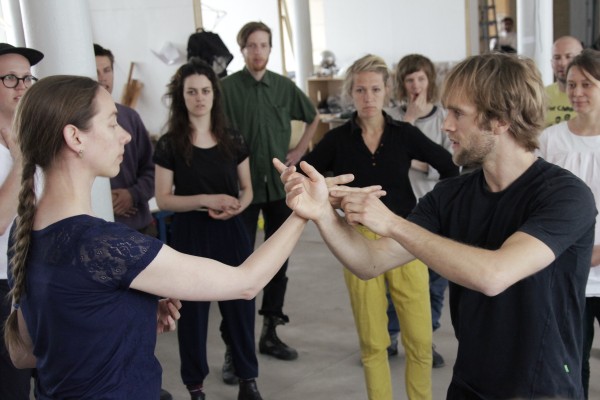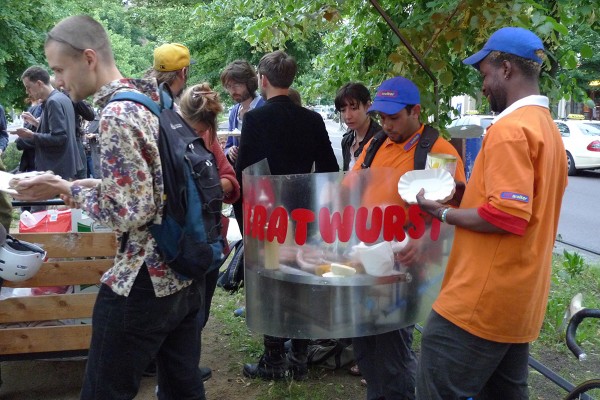12. - 14. Juni 2013
/ Marathon
⟶
PERFORMANCE PERFORMANCE PERFOAMNCE PERFORMANCE PERFORMANCE PERFORMANCE PERFORMANCE PERFORMANCE PERFORMANCE PERFORMANCE PERFORMANCE PEROFMRANCE PERFORMANCE PERFORMANCE PERFORMANCE PERFORAMNCE PERFORMANCE PERFORMACE PEROFRMACEN PEROFORMANCE PERFORMANCE PERFORMANCE PERFORAMCEN PERFOERMANCE PERFORMANCE PERFORMANCE PERFORAMCEN PERFORAMCEN PERFORMEANCE PERFORAMCEN PERFORAMANCE PEROFMRANCE PEROFMANCE PERFORAMANCE *
Contributions byEric Ellingsen, Christian Falsnaes, Kendell Geers, Hannah Hurtzig, Mathis Landwehr, Antje Majewski, Oliver Marchart, Bettina Masuch, Sarah Mewes, Vladimir Miller, Ece Pazarbasi, Lynn Peemoeller, Alexandra Pirici, Cia Rinne, Stephanie Rosenthal, Frédéric Seguette, Simon Starling, Meg Stuart, Sandra Teitge, Joanna Warsza, Christina Werner, Dana Yahalomi
In the 1530’s performance meant the carrying out of a promise. A thing acted out, played, done. Today performance means what? A way of qualifying everything from politics and social entanglements to technology (car engines, computers, drugs), environmental and structural systems to sustainability, something incubating in movement, from dance to theater to acting, to acting art, to singing, or action anything, poetry, on and on.
One thing we think performance means is a relationship to precision, to being precise. A tool for making things felt. Something that can be felt and feeling at the same time. We feel that performance is practiced and a practice, content and content production working of strangely attractive feedback loops from looking and listening to thought to action in which the action keeps thinking going keeping action going keeping thinking going on and on. Something that is generous in terms of audience co‐production. That performance is the relationship of imagination, feeling, thought, and beliefs materializing from one’s language as an artist.
PERFORMANCE PERFORMANCE PERFOAMNCE PERFORMANCE PERFORMANCE PERFORMANCE PERFORMANCE PERFORMANCE PERFORMANCE PERFORMANCE PERFORMANCE PEROFMRANCE PERFORMANCE PERFORMANCE PERFORMANCE PERFORAMNCE PERFORMANCE PERFORMACE PEROFRMACEN PEROFORMANCE PERFORMANCE PERFORMANCE PERFORAMCEN PERFOERMANCE PERFORMANCE PERFORMANCE PERFORAMCEN PERFORAMCEN PERFORMEANCE PERFORAMCEN PERFORAMANCE PEROFMRANCE PEROFMANCE PERFORAMANCE *
Beiträge vonEric Ellingsen, Christian Falsnaes, Kendell Geers, Hannah Hurtzig, Mathis Landwehr, Antje Majewski, Oliver Marchart, Bettina Masuch, Sarah Mewes, Vladimir Miller, Ece Pazarbasi, Lynn Peemoeller, Alexandra Pirici, Cia Rinne, Stephanie Rosenthal, Frédéric Seguette, Simon Starling, Meg Stuart, Sandra Teitge, Joanna Warsza, Christina Werner, Dana Yahalomi
In den 1530er Jahren bedeutete Performance, ein Versprechen einzulösen. Etwas darzustellen, zu spielen und zu tun. Was bedeutet Performance heute? Es ist eine Art Dinge näher zu bestimmen, auf die alles von Politik über soziale Verflechtungen bis hin zu Technologien (Automotoren, Computer, Medikamente), Umweltsystemen und nachhaltigen Strukturen in Bewegung zum Ausdruck gebracht werden kann. Alle Formen von Tanz über Theater, Schauspiel, darstellende Kunst bis hin zu jeglichen Formen von Aktion, Poesie und so weiter sind dabei möglich.
Eine der Eigenschaften, die wir Performance zuschreiben ist die einer besonderen Beziehung zu Präzision und zum präzise sein. Sie dient als Werkzeug, um Dinge fühlbar zu machen: Etwas das gefühlt werden kann und gleichzeitig Gefühl ist. Wir denken, dass Performance praktiziert wird und eine Praxis ist, Inhalt und Inhaltsproduktion ist, das Produkt seltsam attraktiver Rückkopplungsschleifen zwischen Schauen und Hören, Gedanken und Handlung ist. Diese Handlung wiederholt dann immer und immer wieder den Prozess des Denkens, Tuns, Aktivbleibens und wieder Denkens. Eine solche Art von Performance bedeutet die Beziehung zwischen Vorstellung, Gefühl, Denken und Glauben, die sich ausgehend von der Sprache eines jeden Künstlers darin materialisiert.



